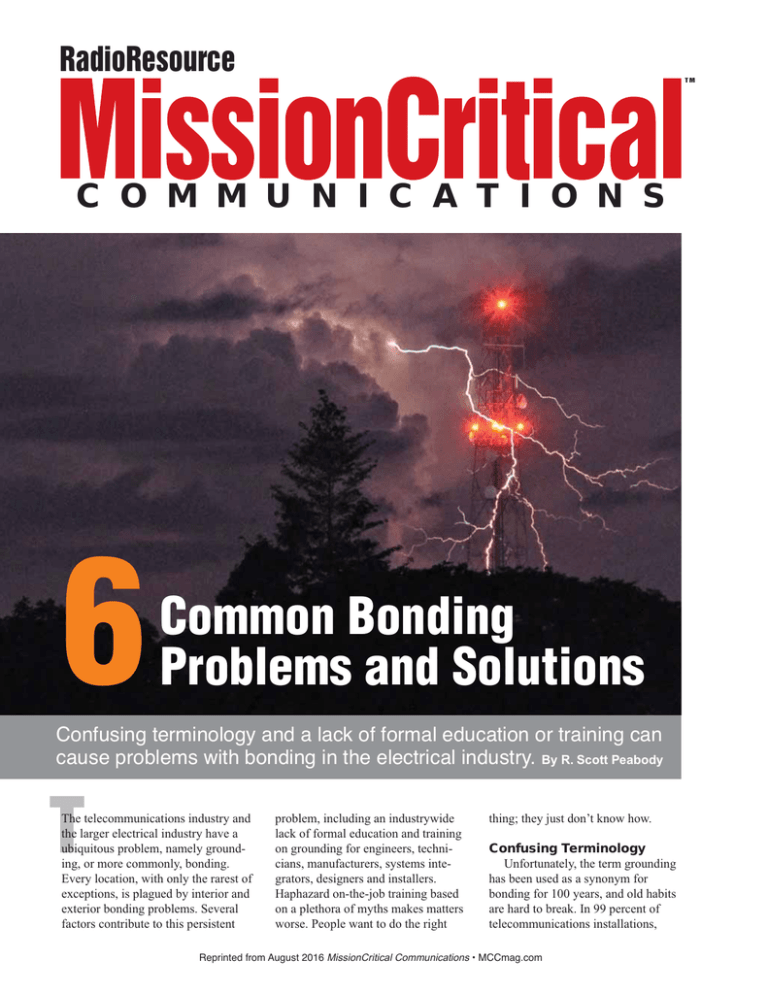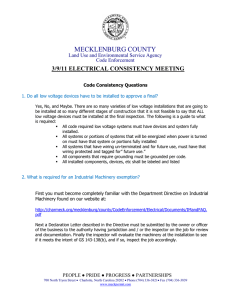
RadioResource
TM
C O M M U N I C A T I O N S
6
Common Bonding
Problems and Solutions
Confusing terminology and a lack of formal education or training can
cause problems with bonding in the electrical industry. By R. Scott Peabody
T
The telecommunications industry and
the larger electrical industry have a
ubiquitous problem, namely grounding, or more commonly, bonding.
Every location, with only the rarest of
exceptions, is plagued by interior and
exterior bonding problems. Several
factors contribute to this persistent
problem, including an industrywide
lack of formal education and training
on grounding for engineers, technicians, manufacturers, systems integrators, designers and installers.
Haphazard on-the-job training based
on a plethora of myths makes matters
worse. People want to do the right
thing; they just don’t know how.
Confusing Terminology
Unfortunately, the term grounding
has been used as a synonym for
bonding for 100 years, and old habits
are hard to break. In 99 percent of
telecommunications installations,
Reprinted from August 2016 MissionCritical Communications • MCCmag.com
Photo courtesy R. Scott Peabody
The bare ground conductor should be replaced with green-jacketed 2 AWG ground wire
and detached from the metal conduit.
bonding, rather than grounding, is
involved. The National Electrical
Code (NEC) defines bonding as, “the
permanent joining of metal parts to
form an electrically conductive path
that ensures electrical continuity and
the capacity to conduct safely any
current likely to be imposed.” In
communications systems, bonding
eliminates the electric potential difference, known as voltage, and static
discharge between pieces of equipment. The current resulting from the
voltage difference and the static discharge may damage the equipment in
its path.
Grounding is defined in the NEC
as, “Establishing a connection,
whether intentional or accidental,
between an electrical circuit or equipment and the earth or some conducting body that serves in place of the
earth.” For instance, the installation of
a ground rod or a more complex
grounding electrode system is grounding. Typically, the installation of a
grounding electrode system occurs
one time for an equipment enclosure,
and bonding occurs with the installation of every piece of equipment.
The grounding electrode system is
a buried system of grounding elements providing a bonding point to
the soil at the site. A ground rod or
electrode driven into the earth for a
residential alternating current (AC)
power service is a simple grounding
electrode system. Grounding electrode systems for communications
sites are typically more complicated
with multiple electrodes, buried
conductors, rings, ground plates,
concrete-encased electrodes or rebar,
and more. Grounding electrode conductors are the wire, typically 2
American wire gauge (AWG), connecting the grounding electrode system to a ground bus bar.
The first step in solving any problem is recognizing there is a problem.
Each of the six most common problems are listed, along with straightforward and usually inexpensive
remedial actions.
1. No Equipment Bonds
(Grounds)
The most common grounding
problem is a lack of equipment
bonds. Proper equipment bonds are
easy to spot with green or green and
yellow striped jackets. The wire size
Unfortunately, the term grounding has
been used as a synonym for bonding for
100 years, and old habits are hard to break.
is typically 6 AWG, although larger
wire to 2 AWG is used for longer
runs. To add more confusion, larger
wire sizes have smaller numbers and
vice versa. The grounding conductors
used for power applications — 12
AWG solid conductor wire with bare
or green jackets — are not proper for
this application.
The fix: Install green-jacketed 6
AWG stranded ground wire.
Although not a grounding/bonding issue per se, the most common
cabling problem is attaching communications cables to an electrical
metallic tubing (EMT) conduit with
wire ties. The cable straps or clamps
used to secure the EMT are designed
for the conduit and its content, not the
mechanical demands from the cables
strapped to the conduit.
The fix: Remove the attachments
to the conduit and secure the cables
with proper-sized cable supports.
2. Stacked Lugs
Stacked lugs are another telltale
sign of improper installation and usually a result of poor job planning from
a lack of mounting hardware or bus
bar capacity. Stacked lugs are not permitted because they reduce the area of
contact between the lug and bus bar.
Two-hole lugs are preferred over onehole lugs because they cannot be rotated or slip off the mounting bolt. Fork
tongue lugs suffer from both of these
symptoms and should not be used.
The fix: Unstack the lugs. Replace
fork lugs with one- or two-hole lugs.
Two-hole lugs are preferred.
3. No Rack Ground
Conductor or Bar
It’s hard to bond the rack and the
equipment in it without a rack grounding conductor or bus bar. Best practices include the installation of the
rack bus bar, rack bonds and the rack
grounding conductors as a part of the
rack installation. Chassis connections,
with or without the paint removed,
between the equipment and racks are
not a substitute for equipment bonds.
The choice of rack ground bus (RGB)
is generally a matter of cable management. The bonds from the rack and
equipment should be dressed horizontally to the rack ground bus with
Reprinted from August 2016 MissionCritical Communications • MCCmag.com
4. No Master
Ground Bus Bar
Arguably the most critical component of a ground system, the master
ground bus bar (MGB) is the single
grounding point inside an equipment
enclosure. All interior ground wires
are ultimately bonded to the MGB,
and the MGB is connected to the
earth through the grounding electrode
system. Any telecommunications
shelter, equipment building or room
without an MGB bar has significant
grounding issues. The MGB must be
bonded to the AC power service in
one and only one place, such as the
equipment grounding bar in the service panel, at the same location as the
main bonding jumper.
The fix: Locate the grounding
electrode system, a location for the
MGB and a cable route for the
grounding electrode conductor. Install
the MGB, grounding electrode conductor and the bonding jumper to the
AC neutral-ground bar. Bond the
equipment, racks and cable supports
to the MGB.
Photo courtesy R. Scott Peabody
smooth bends. In general, series or
“daisy chain” connections in all
grounding and bonding conductors are
unacceptable. Racks without a rack
ground bus are also installed without
isolation mounting hardware. To prevent multiple ground paths, the racks
should be mounted to the floor with
visible insulating washers.
The fix: Install an RGB bar or
rack grounding conductor, and bond
the rack and each piece of equipment
to the RGB. If the rack is not isolated from the floor, install a rack isolation kit.
Another common problem with
equipment racks is a lack of seismic
bracing. The equipment in racks can
be heavy, and sometimes the racks
are heavier at the top than the bottom.
During a seismic event, the equipment, racks, cables and their support
systems could fall and injure people
or block exits. Further, the equipment
could become damaged and inoperable. Seismic bracing is beyond the
scope of this article, but the same
approach of recognizing the problem
so it can be corrected applies to seismic bracing.
Unstack one-hole lugs and dress cabling.
5. No Interior Perimeter
Ground Bus
The interior perimeter ground bus
(IPGB) has a tongue twister name so
it’s usually called the IPGB, halo or
ring. Unfortunately, the terms halo
and ring connote a loop and are misleading. The IPGB has a separation to
prevent loop currents, so it’s not a
ring. The IPGB provides a bus for
bonding ancillary support equipment,
such as DC power plants, cabinets,
racks, cable trays, metallic conduit,
metallic building structures and piping systems, and surge protection
devices. Not all enclosures require an
IPGB; it’s not required in rooms in a
large building or when it’s more practical to bond the ancillary support
equipment directly to the MGB. An
IPGB is recommended for tower
sites. The IPGB is a 2 AWG conductor located 1 foot from the ceiling
around the perimeter of the enclosure
with support standoffs every 2 feet.
The fix: Determine if an IPGB is
required. Install an IPGB if needed
and bond all ancillary support equipment to it.
6. No Exterior Bonds to
Metallic Objects
The number of unlicensed exterior point-to-point and point-to-multipoint Wi-Fi installations has
increased exponentially during the
past decade. Very few of these
installations are properly bonded.
It’s not just Wi-Fi sites. Metallic
objects such as antenna pipe
mounts, roof sled antenna mounts
and metallic objects within 6 feet of
an external ground electrode system
or within 6 feet of a grounded
metallic object should be bonded to
the external grounding electrode
system. This requirement applies to
a long list of metallic objects including antenna mounts, fences, fence
posts and gates, ice bridges, generator frames, metallic components of
incoming telecommunications
cables, metallic entry points, metallic conduits and raceways, metallic
pipes, heaters, air conditioning
units, storage tanks and external
light fixtures or support masts. The
exterior connections to heavy metal
objects such as tower legs, support
posts, exterior ground bus bars and
grounding conductors use exothermic welding, a permanent connection using a chemical reaction to
heat the welding materials — or
irreversible compression.
Rather than memorize the list of
metal parts, remember the 6-foot distance in the context of touch voltage
or its synonym touch potential. Touch
voltage is the potential difference
Reprinted from August 2016 MissionCritical Communications • MCCmag.com
between two points on the human
body in contact with metal parts or
the earth. The body completes a circuit between the two points — one
hand to the other hand or one hand to
one foot produces a current flow.
Bonding these metal parts to the
grounding electrode system removes
the touch voltage to protect from
lethal shock.
The fix: Bond all metal parts
within 6 feet of an external ground
electrode system or grounded metal
part. For heavy metal parts, use
exothermic welds or irreversible
compressions.
Look for these common bonding
problems; they are everywhere. Be
aware of the confusing terminology
and try to use the correct language
when explaining the issues. Discuss
bonding problems with colleagues at
training and safety meetings and
develop a plan to fix them. Working
together, the communications and
large electrical industries can solve
grounding and bonding problems. n
R. Scott Peabody is a senior consultant for
Adcomm Engineering and a registered
professional engineer (PE) with more than
25 years of experience in telecommunications, electrical power systems and IT. He
speaks regularly at national and regional
technical conferences and has authored a
number of technical articles focusing on
the practical application of technologies to
address real-world problems. Email feedback to s.peabody@adcomm911.com.
RadioResource MissionCritical Communications delivers wireless voice and data solutions for mobile and remote mission-critical operations. Editorial content
targets organizations in the United States and Canada with mobile and remote communications needs, including public safety, government, transportation,
manufacturing, utility/energy, business, and industrial entities. The magazine covers industry news; case studies; innovative applications; product information;
emerging technologies; industry reports and trends; and technical tips. RadioResource MissionCritical Communications is published by RadioResource Media
Group. Pandata Corp., 7108 S. Alton Way, Building H, Centennial, CO 80112, Tel: 303-792-2390, Fax: 303-792-2391, www.RRMediaGroup.com. Copyright 2016
Pandata Corp. All rights reserved. Reprinted from the August 2016 issue of RadioResource MissionCritical Communications. For subscription or advertising
information please call 303-792-2390 or visit www.RRMediaGroup.com.
Reprinted from August 2016 MissionCritical Communications • MCCmag.com


